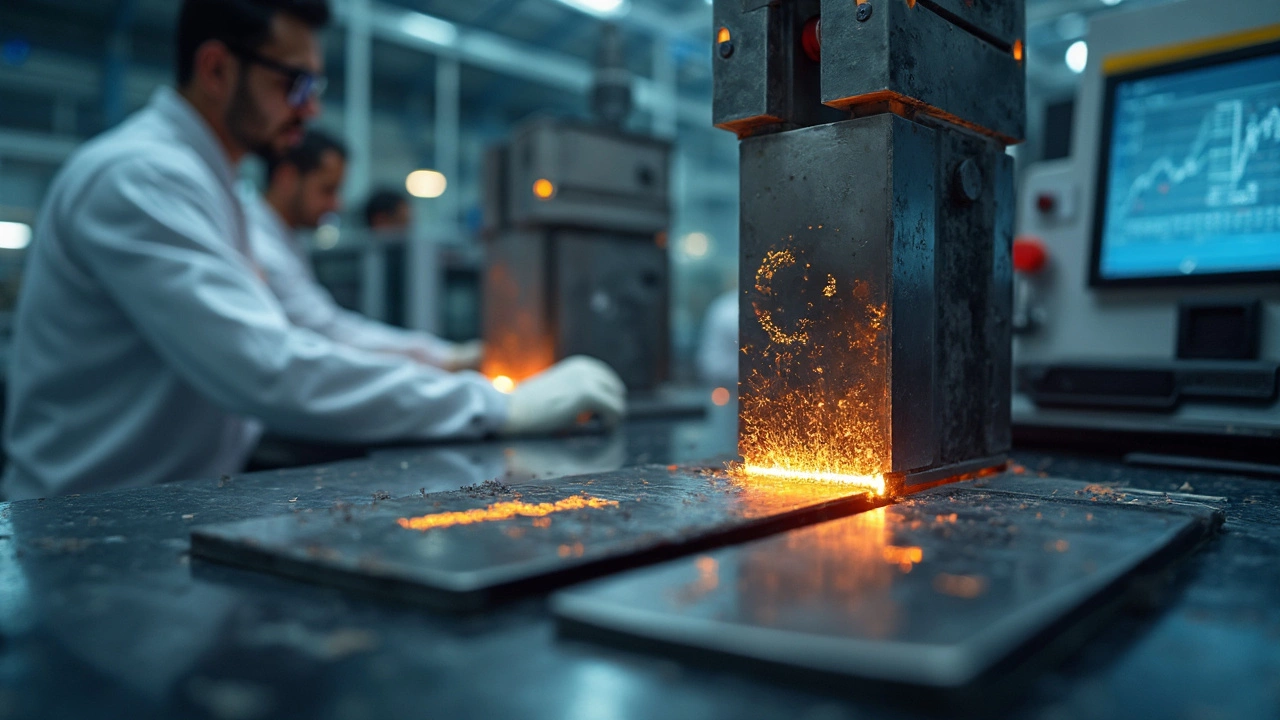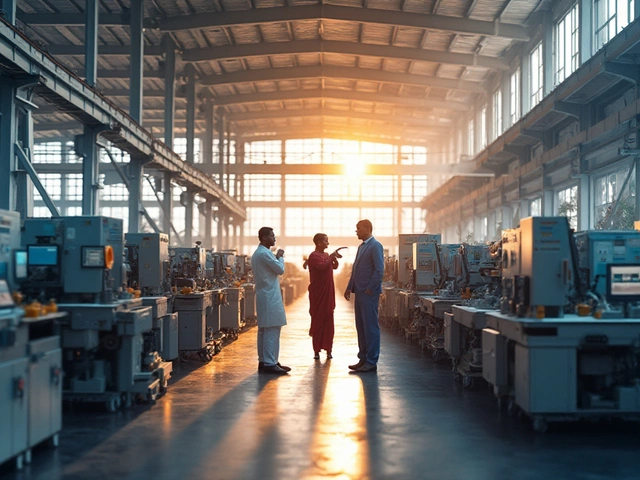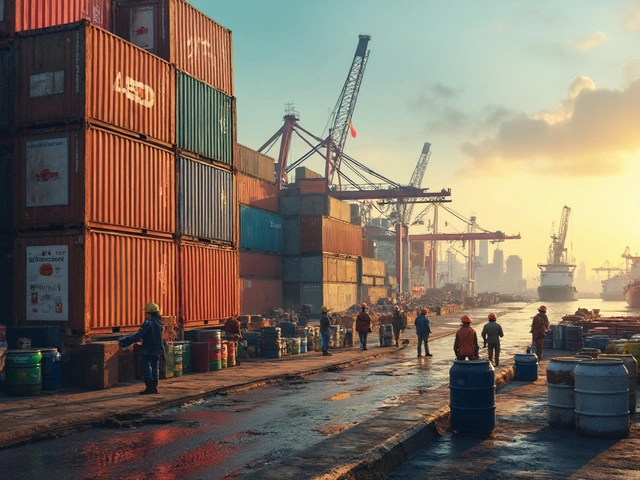
Think picking steel is simple? Not so fast. Whether you’re building a skyscraper or fixing up your garage, the question of American steel versus Chinese steel is a big deal. People say American steel is stronger, but is it really that straightforward?
Let’s cut through the noise. When you’re choosing steel, you’re not just comparing two countries. You’re comparing different rules, levels of oversight, and ways of doing business. If you’ve ever tried to read a technical data sheet and wondered what half the codes mean, you’re not alone. The truth is, what makes steel “stronger” isn’t just the country of origin—it’s how it’s made, tested, and certified.
Here’s what actually matters: how the steel is produced, the standards it has to meet, and whether you can trust those standards were followed. If you think it’s all the same, you might be surprised by how much difference a country’s rules can make. Let’s break down where those differences show up, what that means on the job, and how you can make the smartest call for your project.
- How Steel Gets Its Strength
- Steel Standards: USA vs China
- Real World Testing: Who Comes Out On Top?
- What This Means for Builders and Buyers
How Steel Gets Its Strength
If you ask any expert in the steel manufacturing world what gives American steel or Chinese steel its muscle, they’ll point to three things: ingredients, processing, and quality checks. Steel isn’t just one metal—it’s mostly iron, mixed with carbon and sometimes with extras like manganese, nickel, or chromium. The exact recipe changes everything. For example, just a bit more carbon and you get more strength, but you can also make it more brittle if you overdo it.
How steel is heated and cooled—called heat treatment—plays a huge role. There’s a reason some steel can bend without snapping, while another batch of the same thickness cracks under pressure. Mills in the US often use something called the Electric Arc Furnace (EAF) method, which melts scrap steel at super high temperatures for tight control over final quality. In contrast, many Chinese steel plants still rely on the older blast furnace method, especially for mass production. That doesn’t automatically make one weaker or stronger, but EAF gives more control over impurities and consistency.
Let’s talk numbers for a minute. Structural steel in the US, like ASTM A36, is required to have a minimum yield strength of 36,000 psi (that’s pounds per square inch). In China, a common standard like Q235 demands a yield strength of 33,000 psi. On paper, they look close, but consistency is the real issue. Not every batch actually holds up to its specs if rules aren’t followed strictly.
| Steel Type | Min. Yield Strength (psi) | Main Use |
|---|---|---|
| ASTM A36 (USA) | 36,000 | Building Frames |
| Q235 (China) | 33,000 | Construction |
Another factor is quality control. American mills stick to industry and government audits, which means random tests and paperwork trails you can actually check. Chinese mills are catching up, especially for exports, but sometimes quality checks are just a handshake. That’s not to say all US steel is flawless or all Chinese steel is bad—but there’s more room for mix-ups or cutting corners where rules aren’t tight.
Bottom line: If you want steel strength you can count on, don’t just focus on where it’s from—learn how it was made and what standards it met. And if you ever get the specs, pay close attention to those numbers and any testing data. That’s the best way to judge what you’re really getting.
Steel Standards: USA vs China
Here’s where things get interesting. Both the U.S. and China make tons of steel, but the rules they follow aren’t the same. If you’re working on a project where safety matters, this can make a big difference.
American steel has to meet standards like ASTM (American Society for Testing and Materials) and AISI (American Iron and Steel Institute). These groups don’t mess around: they set specific requirements for strength, chemistry, and performance. Every batch is tested, and records are kept. If a plant cuts corners, they risk getting shut down or fined—nobody wants that.
In China, the main body is the GB (Guobiao) system. There are rules, but they aren’t always enforced with the same intensity as in the U.S. There are solid Chinese steel companies that do great work, especially in big cities or for export. But in some cases, loose oversight means you can’t always be sure what you’re getting, especially if it’s a cheap, off-brand product.
Here’s how some of the standards stack up:
| Country | Common Steel Standard | Strength Test Requirement | Certifications Issued |
|---|---|---|---|
| USA | ASTM A36, ASTM A992 | Yes, every batch | Mill Test Report (MTR), Certified |
| China | GB/T 700 Q235, Q345 | Yes, but varies by supplier | Some offer certificates, not all do |
With American steel, you’ll almost always get a Mill Test Report. That’s a document showing the actual strength and mix of the batch you’re buying. In China, you might get a certificate, but sometimes you have to push for it, especially with smaller mills.
One frustrating thing we ran into while renovating my garage was getting documentation for the steel beams. The U.S. supplier handed over the reports, no questions asked. When I checked out a cheaper import option online, it was like pulling teeth to get any paperwork at all. If your job needs proof of strength—like buildings, bridges, or anything with lives on the line—play it safe: make sure you actually get those reports, no matter where you buy.
Bottom line: standards exist in both places, but they aren’t enforced the same way. If you care about quality, insist on up-to-date batch certifications and check that suppliers stick to proven steel quality standards.

Real World Testing: Who Comes Out On Top?
When it comes to steel strength and reliability, lab numbers are only half the story. Real world testing happens on actual construction sites and manufacturing floors, where steel needs to handle everything from heavy trucks to wild weather. Here’s what serious tests—and a few headline failures—have shown about American steel and Chinese steel.
First, let’s talk about quality control. Most American steel is produced in plants that stick to tight rules set by ASTM (American Society for Testing and Materials). These rules cover everything from measuring composition to real stress tests under tons of pressure. In contrast, some Chinese plants do follow similar ISO standards, but reports on inconsistencies still pop up—especially with bargain-priced batches for export.
Remember that San Francisco Bay Bridge flap back in the early 2010s? Construction used Chinese steel, and inspectors found cracks and dodgy welds during safety checks, causing huge delays and millions in repairs. It’s a solid example of what can go wrong when steel isn’t tested or certified to the same level.
If you put both American and Chinese steel through side-by-side stress tests—like tensile strength (pulling it until it snaps) and impact tests—American steel usually shows more consistent results. Engineers have found it tends to match its labeled grade without breaking a sweat, while imported steel can be hit or miss. For projects where safety is top priority (think bridges, stadiums, or schools), that consistency matters a lot.
| Type | Typical Yield Strength (MPa) | Typical Tensile Strength (MPa) | Reported Consistency |
|---|---|---|---|
| American ASTM A36 | 250 | 400-550 | Very Reliable |
| Chinese Q235 | 235 | 370-500 | Inconsistent for Some Exports |
But don’t assume all Chinese steel is poor quality. Top Chinese brands, especially those selling within China’s own market, hit excellent marks. The issue comes when you’re not sure what you’re getting, or when it’s coming from a no-name exporter. If you’re ordering steel for a big project, you want test certificates and maybe even third-party lab results, not just a sales pitch.
Bottom line? American steel wins for reliability and consistency in independent tests, especially for critical builds. If you need cheap rebar for a home shed, lower-grade imports might be fine. But for bridges or high-rises, the results point to American steel as the safer bet.
What This Means for Builders and Buyers
If you’re a builder, project manager, or just someone planning a big DIY, here’s the blunt truth: choosing American steel or Chinese steel will shape your project's outcome in ways you might not see at first glance. It’s not just about price—although that’s usually the first thing everyone notices. It’s about what you actually get for your money, and how much headache you might be saving (or inviting) down the road.
American steel plants follow strict U.S. standards, like those from the American Society for Testing and Materials (ASTM) and the American Iron and Steel Institute (AISI). This means when an American supplier says you’re getting a certain grade of steel, you can bet it passed the tests. Plus, steel made in the U.S. is traceable. Need paperwork for every batch? American mills will have it ready because inspectors demand it.
Chinese steel is everywhere because it’s usually cheaper. But there’s a catch: standards can be hit or miss, depending on the manufacturer. While big, reputable Chinese firms make solid products, there have been stories of mislabeled strength grades or subpar batches slipping past quality control. For something like a residential fence, you might not notice. For a highway bridge or a high-rise, those shortcuts can be dangerous.
Check out a quick breakdown of a few key points that matter most for steel strength and reliability:
- Certifications: U.S. steel is often accompanied by ASTM or AISI certs. Chinese steel can come with different or less-recognized certifications. Always ask for proof and clarify what the documents mean.
- Consistency: U.S. suppliers almost always deliver products that meet grade promises. In China, quality can vary if you don't buy from a top-tier source.
- Price vs. Value: Chinese steel is cheaper up front, but project delays or replacements can wipe out any savings if there’s a problem.
- Lead Times: Imported steel can see delays at the port, while local mills can sometimes rush orders or handle last-minute changes.
Here’s a sample snapshot that shows where things stand on the ground:
| Factor | American Steel | Chinese Steel |
|---|---|---|
| Common Certification | ASTM, AISI | GB, ISO |
| Traceability | High (batch & paperwork) | Medium to Low (varies) |
| Typical Price (2024, per ton) | $1,200-$1,600 | $700-$1,100 |
| Consistent Quality | Very High | Medium to High (depends on source) |
So, what’s the right move? For major structural projects—skyscrapers, stadiums, bridges—reliable specs and clear paperwork should win out every time. On the flip side, if you’re building a shed or a basic fence, cheaper steel might be good enough.
My advice? Always dig for real documentation, especially on bigger jobs. And don’t just buy the cheapest option hoping for the best—your project’s safety and your own peace of mind are worth a little extra time and money.




